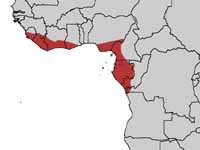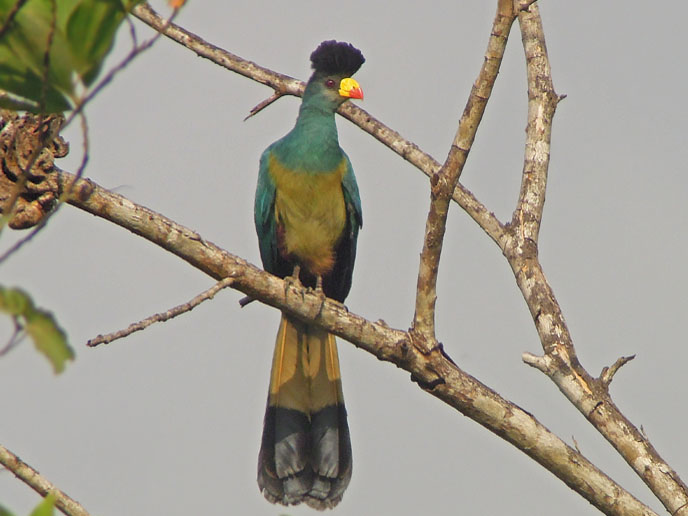THE WORLD BIRDS - An Online Bird Book
TURACOs, GO-AWAY-BIRDS and their Allies
Order Musophagiformes Family Musophagidae
TURACOs, GO-AWAY-BIRDS and their Allies
Order Musophagiformes Family Musophagidae
The turacos make up the bird family Musophagidae (literally "banana-eaters"), which also includes plantain-eaters and go-away-birds. Contrary to what the names might suggest, they generally do not eat bananas or plantains. The turaco family is the only family in the Musophagiformes order.
In southern Africa both turacos and go-away-birds are commonly known as louries. The go-away-birds and plantain-eaters are mainly grey and white. The turacos on the other hand are brightly colored birds, usually blue, green or purple. Musophagids often have prominent crests and long tails. All family members have 3 forward toes and one to the rear. The rear toe is flexible and can be pointed forward if desired. They are gregarious birds that do not migrate. Many species are noisy, with the go-away-birds being especially noted for their piercing alarm calls.
The turacos are medium-sized arboreal birds endemic to sub-Saharan Africa, where they live in forests, woodland and savanna. Their flight is weak with short a few wing-beats followed by a glide, but they run quickly through the tree canopy. They feed mostly on fruits and to a lesser extent on leaves, buds, and flowers, occasionally taking small insects, snails, and slugs. Turcacos are an important in the dispersal and germination of fruit seeds.
Genus Corythaeola - 1 species
Turaco,_Great_Blue Corythaeola cristata
Description: The great blue turaco has mainly greyish-blue upperparts. It has a large black crest, whitish chin, and a yellow bill with a red tip. The neck and upper-breast are blue-grey. It has a yellow-green lower-breast and a yellow belly. Its nearest relatives are the go-away birds. The great blue turaco is 70 to 75 cm long. It nests high in a tree in a platform made out of sticks, both parents incubate and feed the chicks.
Range: Central Africa.
Habitat: Prefers the rainforest, but has also adapted to clear areas.
Diet: Fruits, flowers, leaves.
Conservation status: Least Concern.
Image by: 1) Bernard_Dupont - Uganda 2) Nik_Borrow - Uganda 3, 4) Dick Daniels - San Diego Zoo Range: Central Africa.
Habitat: Prefers the rainforest, but has also adapted to clear areas.
Diet: Fruits, flowers, leaves.
Conservation status: Least Concern.
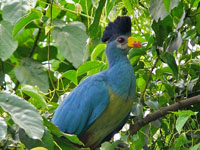
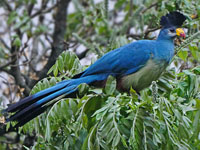

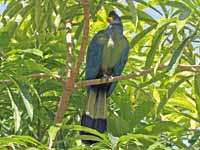
Genus Corythaixoides
The go-away-birds are so name because of their loud "go away" call. They are grey and white, with a large erectile crest, and long tail. Go-away-birds most common food is fruit, especially figs. All three species are distinctive and easy to tell from each other. Their nearest relatives are the plantain eaters and some include the go-aways in that genus.
Go-away-bird,_Bare-faced Corythaixoides personatus
Description: The bare-face go-away-bird has grey upperparts. It has a grey crest, white neck, white upper-breast. It identifying feature is the bare black face. The lower-breast has a green patch and the belly is pinkish-brown. Nests are often built in tall acacia trees. The bare-face go-away-bird is up to 48 cm long.
Range: East Africa from Ethiopia to Tanzania. Also Uganda, Rwanda, Burundi, Malawi, Zambia.
Habitat: Woodlands and areas with scattered trees.
Diet: Fruits, leaf buds, seeds.
Conservation status: Least Concern.
Image by: 1, 2 3) Dick - Keekorok Lodge in the Masai Mara, Kenya 4) Tarique_Sani - Tanzania Range: East Africa from Ethiopia to Tanzania. Also Uganda, Rwanda, Burundi, Malawi, Zambia.
Habitat: Woodlands and areas with scattered trees.
Diet: Fruits, leaf buds, seeds.
Conservation status: Least Concern.



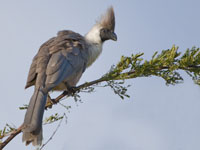
Go-away-bird,_grey also grey Lourie Corythaixoides concolor
Description: The grey go-away-bird has smoky-grey plumage including its crest. The underparts are paler. The bill is black and the tongue is pink. The grey go-away-bird is 47 to 51 cm long.
Range: Central and southern Africa.
Habitat: Woodlands and areas with scattered trees.
Diet: Fruits, leaf buds, seeds; also termites, snails.
Conservation status: Least Concern.
Image by: 1) Sandy Cole - Kruger National Park, South Africa Range: Central and southern Africa.
Habitat: Woodlands and areas with scattered trees.
Diet: Fruits, leaf buds, seeds; also termites, snails.
Conservation status: Least Concern.
2) Dick Daniels - Birds of Eden 3) Bernard_Dupont - South Africa 4) Tude e João - South Africa



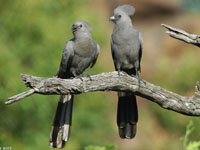
Go-away-bird,_White-bellied Corythaixoides leucogaster
Description: The white-bellied go-away-bird has grey upperparts, neck, and upper-breast. Its very large crest is blackish. It has a white lower-breast, and belly. The long and pointed dark tail has a white median band. The male has a black bill white the female has green bill. The white-bellied go-away-bird is about 50 cm long.
Range: Eastern Africa.
Habitat: Woodlands and areas with scattered trees.
Diet: Fruits, leaf buds, seeds; also termites. Some consider it a pest for the fruits it eats.
Conservation status: Least Concern.
Image by: 1, 4) Lip Kee - Tanzania 2) Alastair Rae - Kenya 3) Yathin S Krishnappa - Tanzania Range: Eastern Africa.
Habitat: Woodlands and areas with scattered trees.
Diet: Fruits, leaf buds, seeds; also termites. Some consider it a pest for the fruits it eats.
Conservation status: Least Concern.
1) Female 2 - 4) Male
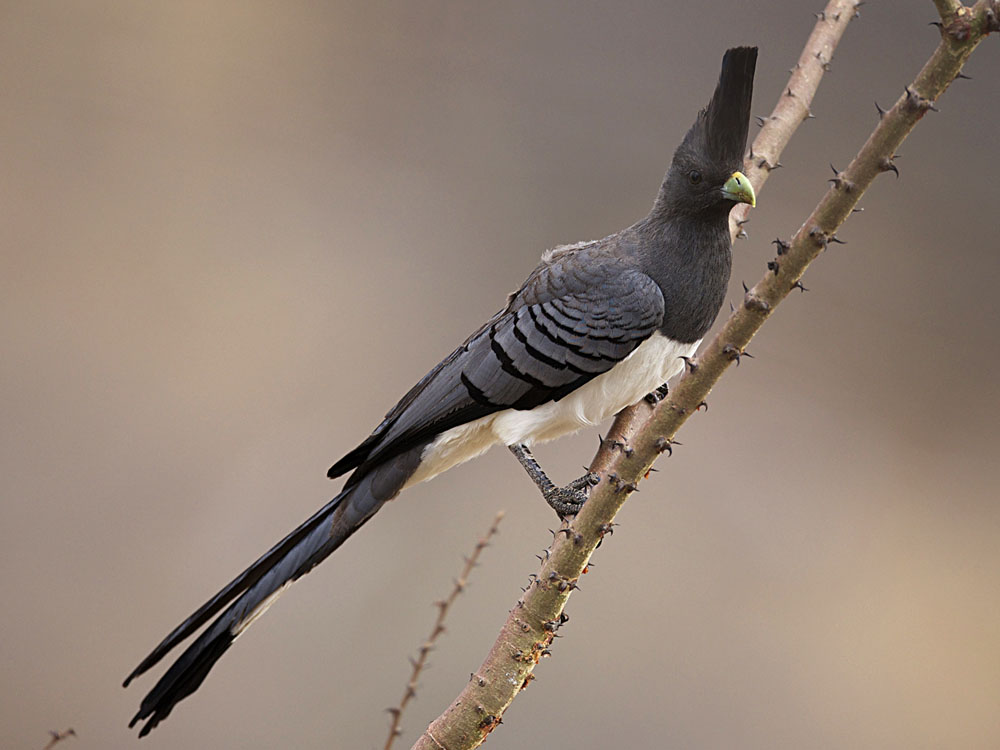
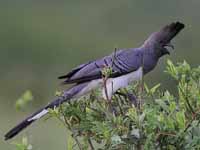
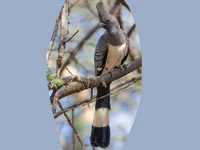

Genus Crinifer
The plantain-eaters, like the go-away-birds, are large, crested, noisy, and conspicuous.
Plantain-eater,_Eastern Crinifer zonurus
Description: The eastern plantain-eater has mainly grey upperparts spotted with brown. It has a brown streaked with silver head, neck, and upper-breast. The rest of underparts are whitish heavily streaked with brown. It has a thick greenish-yellow bill. The long tail has wide black-white-black bands. Nests are often built in tall trees out of sticks. The eastern plantain-eater is about 50 cm long. Unlike the western plantain-eater, the eastern plantain-eater has tail bars.
Range: East central Africa.
Habitat: Woodlands and areas with scattered trees.
Diet: Mainly fruits, especially figs. Also flowers, buds.
Conservation status: Least Concern.
Image by: 1) Charles_J_Sharp - Uganda 2) Noel_Reynolds 3) Francesco_Veronesi - Uganda 4) Lip Kee - EthiopiaRange: East central Africa.
Habitat: Woodlands and areas with scattered trees.
Diet: Mainly fruits, especially figs. Also flowers, buds.
Conservation status: Least Concern.
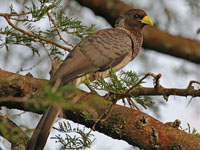

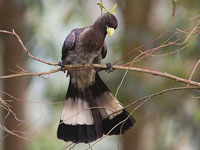

Plantain-eater,_Western Crinifer piscator
Description: The western plantain-eater, also known as the grey plantain eater, is similar to the eastern plantain-eater with the main difference being the black and white banded tail of the eastern.
Range: Central Africa.
Habitat: Open woodlands.
Diet: Mainly fruits, especially figs. Also flowers, buds.
Conservation status: Least Concern.
Image by: 1) Allan_Hopkins - Gambia 2) Frans_Vandewalle - Gambia 3) Joshua_Barnett 4) Sandy Cole - Birds of Eden, South Africa Range: Central Africa.
Habitat: Open woodlands.
Diet: Mainly fruits, especially figs. Also flowers, buds.
Conservation status: Least Concern.
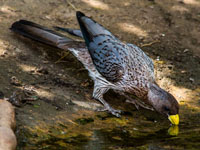

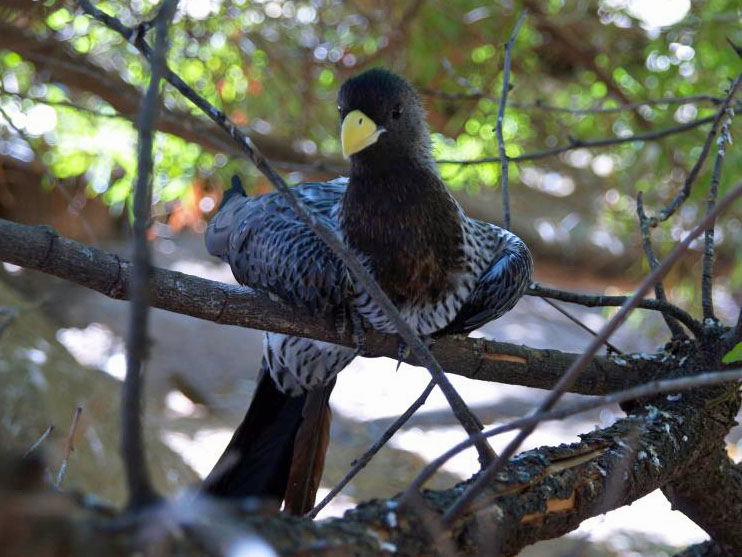
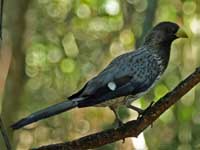
Genus Musophaga
Turaco,_Ross's Musophaga rossae
Description: The Ross's Turaco has mainly dark blue plumage. It has a red crown and red flight feathers. There is a yellow forehead shield and also bold yellow eye-rings. The legs are black legs. The Ross's Turaco is up to 54 cm long.
Range: Central and southern Africa.
Habitat: Woodlands, open forests, and near water.
Diet: Fruits, flowers. Also seeds and insects.
Conservation status: Least Concern.
Image by: 1) Postdlf 2) Ed Schipul - Houstan Zoo 3) Ryan Poplin - Columbus Zoo 4) Josh_MoreRange: Central and southern Africa.
Habitat: Woodlands, open forests, and near water.
Diet: Fruits, flowers. Also seeds and insects.
Conservation status: Least Concern.
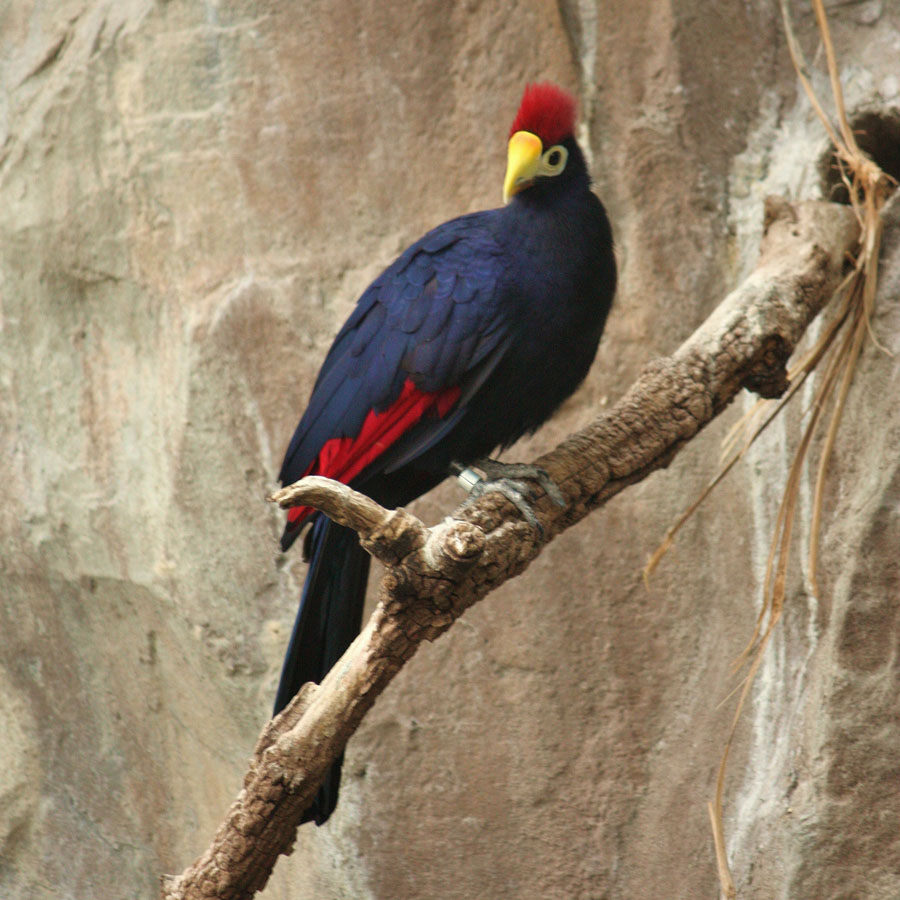
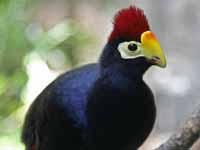

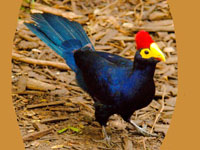
Turaco,_Violet Musophaga violacea
Description: The violet turaco has mainly glossy purple plumage. It has a chestnut crown, red eye-rings, red bill, and yellow frontal shield. There is a thin post-ocular white line. The feet are black. The violet turaco is about 50 cm long.
Range: Central Africa.
Habitat: Varied from savanna and wetlands to forests.
Diet: Mainly Fruits, especially figs. Also flowers, seeds and insects.
Conservation status: Least Concern.
Image by: 1) Dick Daniels - Jacksonville Zoo 2, 3) Dick - Birds of Eden, South Africa 4) Thomas_Brown - Gambia Range: Central Africa.
Habitat: Varied from savanna and wetlands to forests.
Diet: Mainly Fruits, especially figs. Also flowers, seeds and insects.
Conservation status: Least Concern.
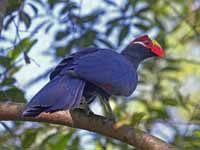
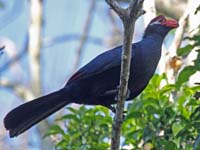


Genus Ruwenzorornis - 1 species
Turaco,_Ruwenzori Ruwenzorornis johnstoni
Description: The Ruwenzori turaco has a green mantle, neck, and breast. Except for the green mantle, the rest of the upperparts are dark blue. Most of the head is dark blue with the face green and the throat black.
Range: Burundi, DR Congo, Rwanda, Uganda.
Habitat: Montane forests above 1500 m.
Diet: Fruits, berries; also insects.
Conservation status: Least Concern.
Image by:
1) John_Gerrard_Keulemans 2) Nik_Borrow - UgandaRange: Burundi, DR Congo, Rwanda, Uganda.
Habitat: Montane forests above 1500 m.
Diet: Fruits, berries; also insects.
Conservation status: Least Concern.

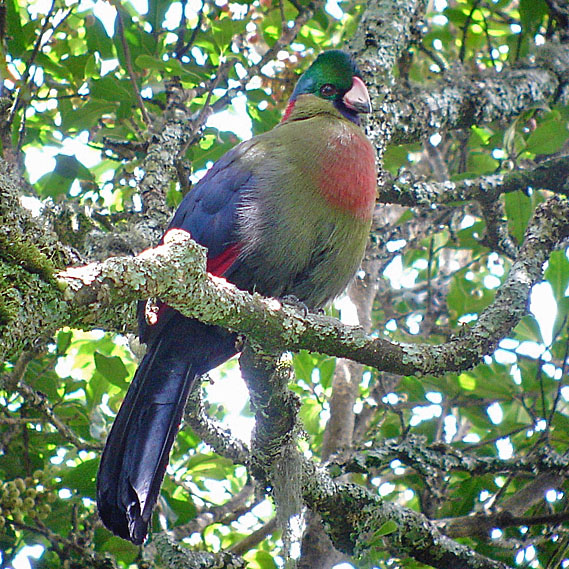
Genus Tauraco
The Tauraco turacos are noted for their green colors. The green is rare in birds as it is due to green in their pigment and not due to structural feather surfaces that interdere with light. They show crimson flight feathers when flying.
Turaco,_Bannerman's Tauraco bannermani
Description: The Bannerman's turaco has green upperparts. It has a dark blue upper-tail. The crown, nape, and crest are red while the rest of the head is grey. It has a green breast and black belly plus under-tail. There are red under-which patches that are visible in flight. It is a shy bird and seldom seen. The Bannerman's turaco is about 43 cm long.
Range: Cameroon.
Habitat: Montane forests and more open woodland that contain some tall trees.
Diet: Mainly fruits and berries.
Conservation status: It is listed as Endangered because of its very small range and declining population due to deforestation.
Image by: 1) Henrik_Gronvold 2) Jose Olivares Compres 3) Nik_BorrowRange: Cameroon.
Habitat: Montane forests and more open woodland that contain some tall trees.
Diet: Mainly fruits and berries.
Conservation status: It is listed as Endangered because of its very small range and declining population due to deforestation.
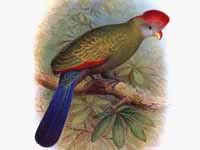


Turaco,_Black-billed Tauraco schuettii
Description: The black-billed turaco has mainly violet-blue upperparts. The head, neck, and breast are green. Its green crest is edged with white. There is a short white line in front of the eye and a longer white line below the eye. It has a black bill. The black-billed turaco is about 40 cm long. The similar green turaco does not have a black bill, a white line under the eye, or a white edge to its crest.
Range: Mainly in DR Congo; also in surrounding countries.
Habitat: Evergreen forests.
Diet: Fruits.
Conservation status: Least Concern.
Image by: 1) Nrg800 2) Mickey Samuni-Blank 3) Nik_Borrow - UgandaRange: Mainly in DR Congo; also in surrounding countries.
Habitat: Evergreen forests.
Diet: Fruits.
Conservation status: Least Concern.


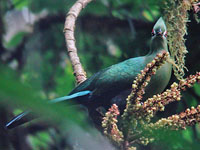
Turaco,_Fischer's Tauraco fischeri
Description: The Fischer's turaco has mainly greenish-blue upperparts. The head is mainly green with a red nape, a short white line in front of the eye, a longer white line below the eye, and black lores between the two white lines. The fore-neck and breast are also green. It has a black belly. The Fischer's turaco is about 40 cm long.
Range: Kenya, Somalia, Tanzania.
Habitat: Moist montane forest, and arable land.
Diet: Mainly fruits; also flowers, buds, and occasionally insects.
Conservation status: It is listed as Near Threatened due ot habit loss.
Image by: 1) Naej 2) Doug_Janson 3) belgian chocolateRange: Kenya, Somalia, Tanzania.
Habitat: Moist montane forest, and arable land.
Diet: Mainly fruits; also flowers, buds, and occasionally insects.
Conservation status: It is listed as Near Threatened due ot habit loss.
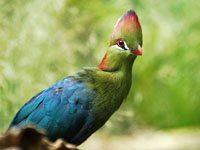
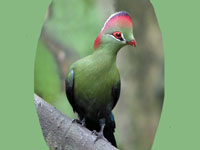

Turaco,_Green Tauraco persa
Description: The green turaco, .also known as the Guinea turaco, has mainly green plumage. It has dark purple wings and tail. There is small white line front of the eye, a black line emanating from the lores, and some subspecies have a another white line below that black line. The bill is red and there is a red eye-ring. It has a black belly and under-tail. The green turaco is up to 43 cm long.
Range: Western Africa, including Guinea
Habitat: Forests, more open woodland that contain some tall trees, forest edges.
Diet: Fruits, blossoms.
Conservation status: Least Concern.
Image by: 1) Sandy Cole - Birds of Eden, South Africa 2) TAN.also known as_Juuyoh 3) Dick Daniels - Birds of
Eden 4) Arthur_Chapman - Birds of EdenRange: Western Africa, including Guinea
Habitat: Forests, more open woodland that contain some tall trees, forest edges.
Diet: Fruits, blossoms.
Conservation status: Least Concern.

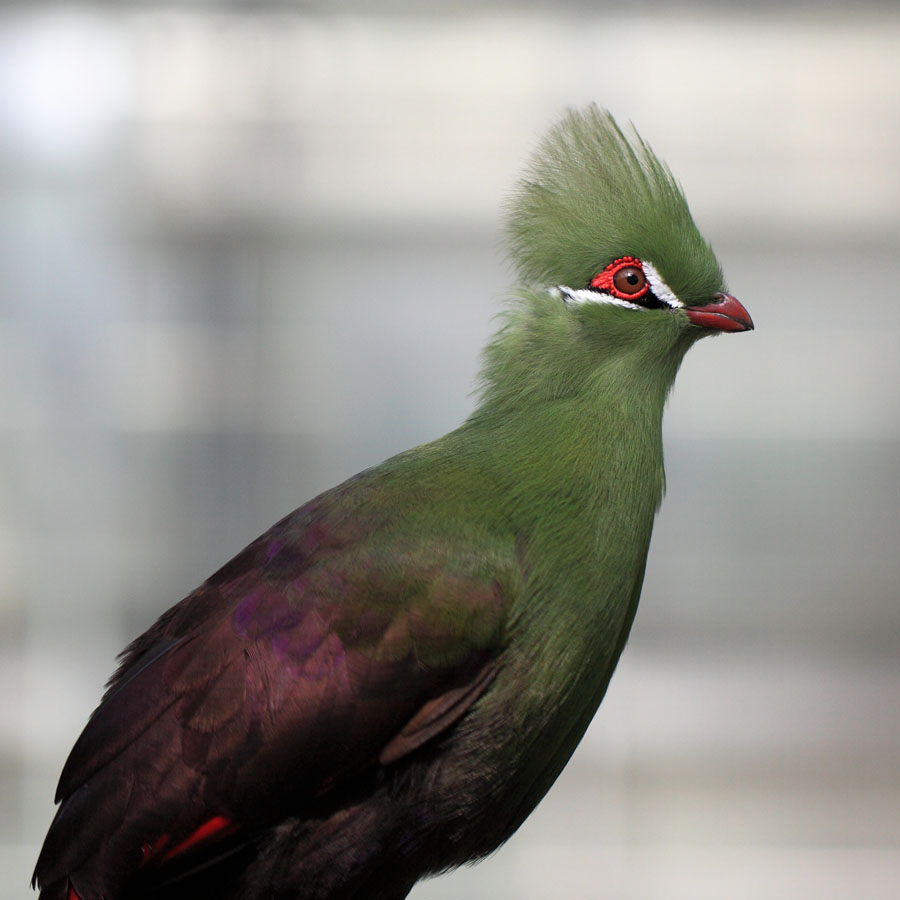


Turaco,_Hartlaub's Tauraco hartlaubi
Description: The Hartlaub's turaco has a dark blue crest and nape. Like most members of this genus it has a narrow line beneath the eye, but uniquely it has a white patch in front of the eye instead of a narrow white line. The rest of the neck is green along with its mantle. The remaining upperparts are blue and the breast is green. The Hartlaub's turaco is about 43 cm long.
Range: Kenya, Tanzania, Uganda.
Habitat: Forests, woodland, gardens.
Diet: Fruits, berries; also insects.
Conservation status: Least Concern.
Image by: 1) Winfried 2) Dick Daniels - Birds of Eden, South Africa 3) Dick - World of Birds, South Africa 4) Nik_Borrow - KenyaRange: Kenya, Tanzania, Uganda.
Habitat: Forests, woodland, gardens.
Diet: Fruits, berries; also insects.
Conservation status: Least Concern.

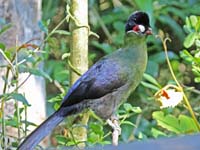

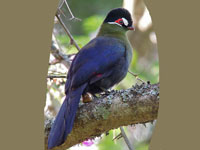
Turaco,_Knysna also Knysna Lourie Tauraco corythaix
Description: The Knysna turaco, .also known as the Knysna turaco, has mainly green plumage. However, the lower mantle , wings, and tail usually look blue due to irredescence. There is a short white line in front of the eye, a longer white line below the eye, and black lores between the two white lines. It has a thick orange-red bill and the tall green crest is tipped with white. The eyes are brown with a deep red eye-ring. The Knysna turaco is up to 47 cm long. Knysna turaco, Livingston's turaco, and Schalow's turaco have been considered conspecific, but they were split into independent species because of different calls.
Range: South Africa. Swaziland.
Habitat: Forests, forest edges
Diet: Fruit, insects, earthworms.
Conservation status: Least Concern.
Image by: 1) Anton Frolich 2) Paul_Bernard - South Africa 3) Brian_Ralphs - Birds of Eden 4) Bernard_Dupont - South AricaRange: South Africa. Swaziland.
Habitat: Forests, forest edges
Diet: Fruit, insects, earthworms.
Conservation status: Least Concern.
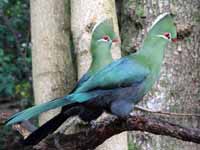
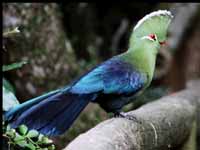

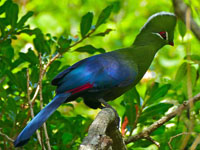
Turaco,_Livingstone's Tauraco livingstonii
Description: The Livingston's turaco has mainly green plumage. However, the lower mantle , wings, and tail usually look blue due to iridescence. There is a short white line in front of the eye, a longer white line below the eye, and black lores between the two white lines. It has a thick orange-red bill and the tall green crest is tipped with white. The eyes are brown with a deep red eye-ring. The Livingston's turaco is up to 46 cm long. Knysna turaco, Livingston's turaco, and Schalow's turaco have been considered conspecific, but they were split into independent species because of different calls. The range of Livingston's Turaco and Schalow's do not overlap.
Range: Southeast Africa.
Habitat: Forests, forest edges.
Diet: Mainly fruits.
Conservation status: Least Concern.
Image by: 1) Netzach 2) Doug_Janson 3) Francesco_Veronesi - Malawi 4) Nik_Borrow - TanzaniaRange: Southeast Africa.
Habitat: Forests, forest edges.
Diet: Mainly fruits.
Conservation status: Least Concern.
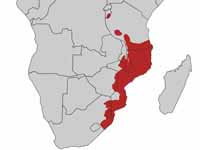
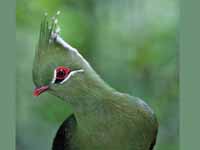


Turaco,_Prince Ruspoli's also Ruspoli's Turaco Tauraco ruspolii
Description: The Prince Ruspoli's turaco, .also known as the Ruspoli's turaco, has greyish-blue lower-mantle while rest of back, wings, and tail are blue, The upper-mantle, fore-head, neck, and breast are green. It has a whitish crest. The bill and orbital skin are red.
Range: Ethiopia.
Habitat: Dry forest.
Diet: Mainly fruit, especially figs.
Conservation status: It is listed as Vulnerable because of its very limited range and loss of habitat.
Image by: 1) netzach 2) Nik_Borrow 3) KrisMaes 4) Nik_Borrow - EthiopiaRange: Ethiopia.
Habitat: Dry forest.
Diet: Mainly fruit, especially figs.
Conservation status: It is listed as Vulnerable because of its very limited range and loss of habitat.

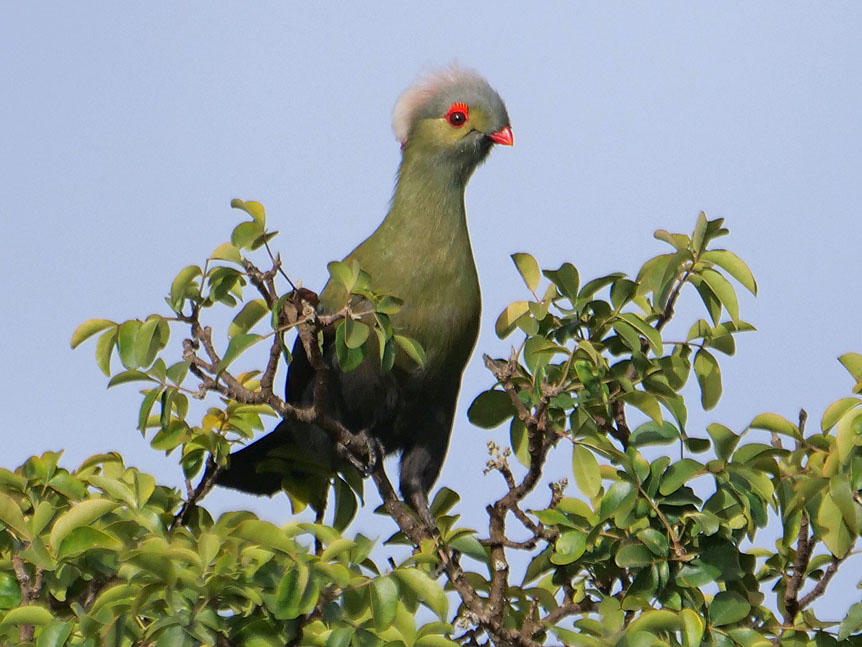
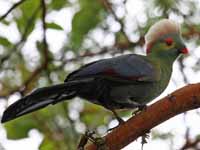

Turaco,_Purple-crested Tauraco porphyreolophus
Description: The purple-crested turaco has a green mantle with the rest of the upper-parts purple. The forehead is black while the crown, crest, and nape are dark purple. It has green underparts. The purple-crested turaco is up to 46 cm long.
Range: Southeast Africa.
Habitat: Moist forests, open woodlands with tall trees.
Diet: Mainly fruit; also insects and snails.
Conservation status: Least Concern.
Image by: 1, 3) Dick Daniels - San Diego Zoo 2) Dick - Tampa's
Lowry Park Zoo 4) Lip_Kee - South AfricaRange: Southeast Africa.
Habitat: Moist forests, open woodlands with tall trees.
Diet: Mainly fruit; also insects and snails.
Conservation status: Least Concern.

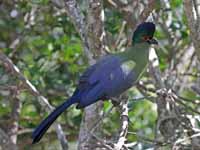

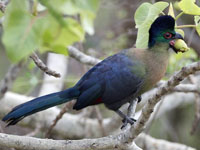
Turaco,_Red-crested Tauraco erythrolophus
Description: The red-crested turaco has green upperparts. It has a dark blue upper-tail. The crest is red, the face is white, and the bill is yellow. It has a green breast and black belly plus black under-tail. There are red under-wing which patches that are visible in flight. The red-crested turaco is about 43 cm long and is the only turaco with a red crest in its range.
Range: Western Angola.
Habitat: Forests and woodlands.
Diet: Fruits.
Conservation status: Least Concern.
Image by: 1) Nathan_Rupert 2) Daniel Demczuk 3) Dick Daniels - San Diego Zoo Range: Western Angola.
Habitat: Forests and woodlands.
Diet: Fruits.
Conservation status: Least Concern.



Turaco,_Schalow's Tauraco schalowi
Description: The Schalow's turaco has mainly green plumage. However, the lower mantle, wings, and tail usually look blue due to iridescence. There is a short white line in front of the eye, a longer white line below the eye, and black lores between the two white lines. It has a thick orange-red bill and the tall green crest is tipped with white. The eyes are brown with a deep red eye-ring. The Schalow's turaco is up to 44 cm long. Knysna turaco, Livingston's turaco, and Schalow's turaco have been considered conspecific, but they were split into independent species because of different calls. The Schalow's turaco has the longest crest of the 3 species. The range of Livingston's Turaco and Schalow's do not overlap.
Range: Mainly Angola, southern DR Congo, Zambia.
Habitat: Forests, forest edges.
Diet: Mainly fruits. Also flowers, buds.
Conservation status: Least Concern.
Image by: 1) Nrg800 2, 3) Nik_Borrow - Malawi, Tanzania 4) Steve_Garvie - KenyaRange: Mainly Angola, southern DR Congo, Zambia.
Habitat: Forests, forest edges.
Diet: Mainly fruits. Also flowers, buds.
Conservation status: Least Concern.


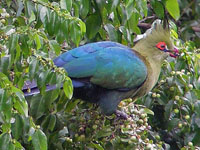

Turaco,_White-cheeked Tauraco leucotis
Description: The white-cheeked turaco has green a mantle plus greyish-blue lower back, folded wings, and tail. It has a small black crest. The white on the cheeks is of varying size, but usually only a small crescent. The lores are also white. It has a red bill and red orbital skin. The white-cheeked turaco is about 42 cm long.
Range: Eritrea, Ethiopia, South Sudan.
Habitat: Montane juniper regions.
Diet: Fruits and juniper berries.
Conservation status: Least Concern.
Image by: 1, 2) Dick Daniels - National Aviary 3) Sandy Cole - National Aviary 4) Nik_Borrow - EthiopiaRange: Eritrea, Ethiopia, South Sudan.
Habitat: Montane juniper regions.
Diet: Fruits and juniper berries.
Conservation status: Least Concern.
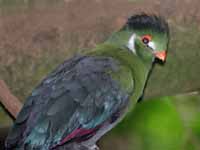
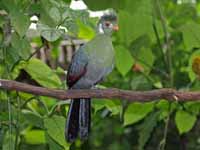
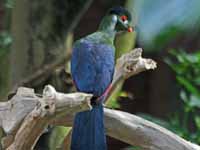
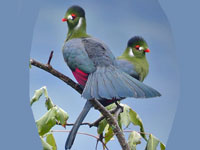
Turaco,_White-crested Tauraco leucolophus
Description: The white-crested turaco has dark blue upperparts with a green upper-mantle. Its head , crest, and neck are white with a black mask. There is a yellow bill and red bare orbital skin.
Range: Central Africa from Nigeria to Kenya.
Habitat: Forests, treed savannas.
Diet: Fruits, berries, flowers; also insects and snails.
Conservation status: Least Concern.
Image by: 1) Steve Wilson 2) Brian 3) Russ_Glasson - Nashville Zoo 4) Ron_KnightRange: Central Africa from Nigeria to Kenya.
Habitat: Forests, treed savannas.
Diet: Fruits, berries, flowers; also insects and snails.
Conservation status: Least Concern.
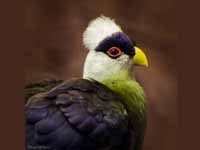
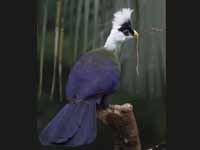
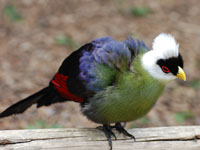
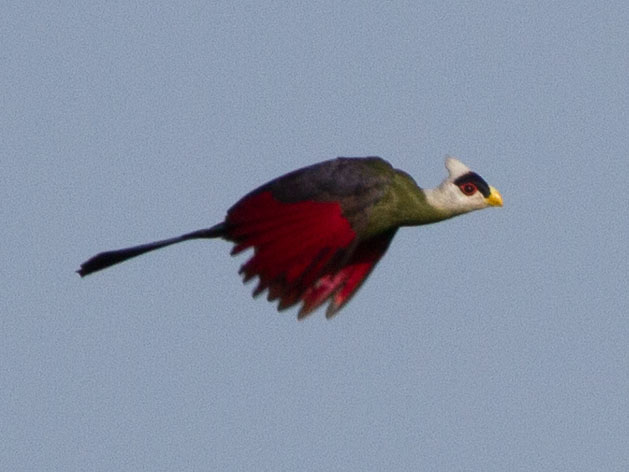
Turaco,_Yellow-billed Tauraco macrorhynchus
Description: The yellow-billed turaco has blue upperparts including the tail. The head, neck, and breast are mainly green. There is a thin white streak below and behind the eye, a yellow bill, and red orbital skin. The yellow-billed turaco is about 42 cm long.
Range: East Africa.
Habitat: Mainly primary forests.
Diet: Fruits, berries,; also buds, insects and snails.
Conservation status: Least Concern.
Image by: 1) Nrg800 2) Francesco_Veronesi - Ghana 3, 4) Nik_Borrow - GhanaRange: East Africa.
Habitat: Mainly primary forests.
Diet: Fruits, berries,; also buds, insects and snails.
Conservation status: Least Concern.
